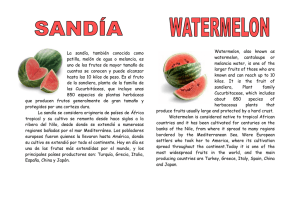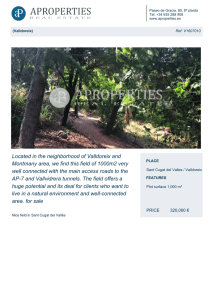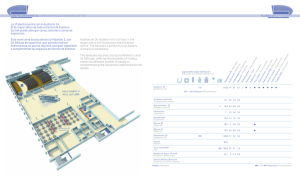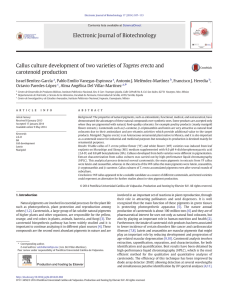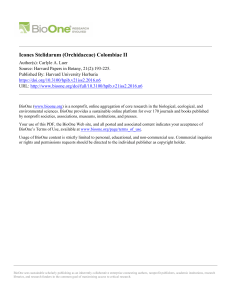7. STELIS ERECTA Duque, sp. nov. Planta grandis epiphytica
Anuncio
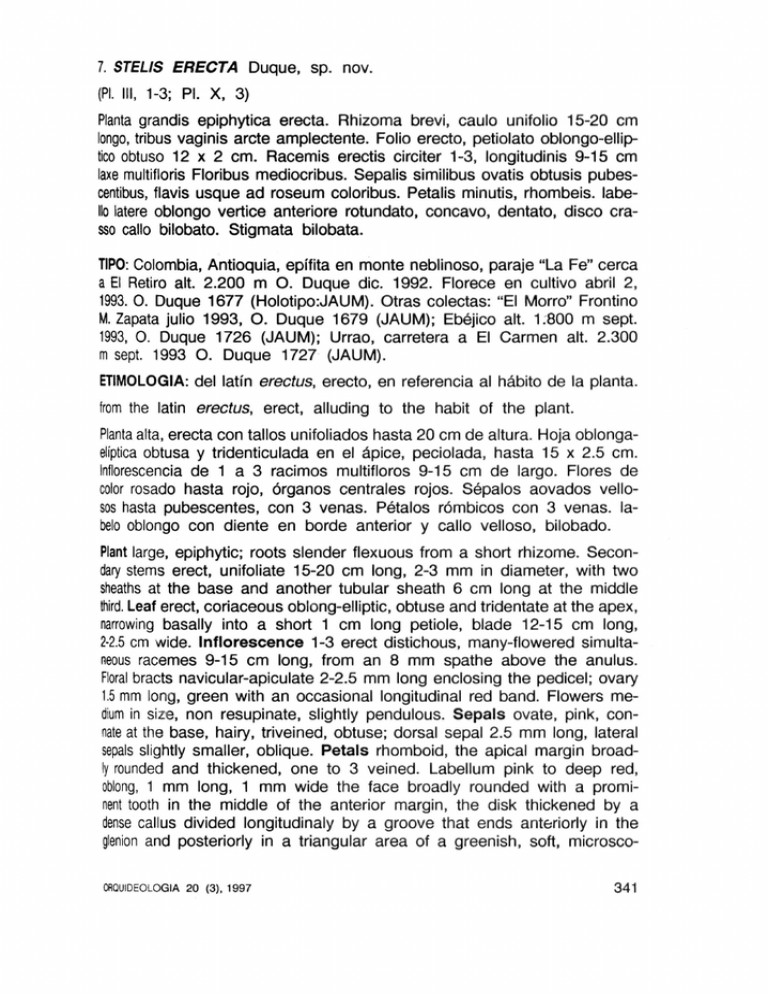
7. STELIS ERECTA Duque, sp. nov. (PI. III, 1-3; PI. X, 3) Planta grandis epiphytica erecta. Rhizoma brevi, caulo unifolio 15-20 cm longo, tribus vaginis arcte amplectente. Folio erecto, petiolato oblongo-elliptieo obtuso 12 x 2 cm. Racemis erectis circiter 1-3, longitudinis 9-15 cm laxe multifloris Floribus mediocribus. Sepalis similibus ovatis obtusis pubescentibus, flavis usque ad roseum coloribus. Petalis minutis, rhombeis. labe110 latere oblongo vertice anteriore rotundato, concavo, dentato, disco crasso callo bilobato. Stigmata bilobata. TIPO: Colombia, Antioquia, epifita en monte neblinoso, paraje "La Fe" cerca a EI Retiro alt. 2.200 m O. Duque dic. 1992. Florece en cultivo abril 2, 1993. O. Duque 1677 (Holotipo:JAUM). Otras colectas: "EI Morro" Frontino M. Zapata julio 1993, O. Duque 1679 (JAUM); Ebejico alt. 1:800 m sept. 1993, O. Duque 1726 (JAUM); Urrao, carretera a EI Carmen alt. 2.300 m sept. 1993 O. Duque 1727 (JAUM). ETIMOLOGIA: del latin erectus, erecto, en referencia al habito de la planta. !rom the latin erectus, erect, alluding to the habit of the plant. Planta alta, erecta con tall os unifoliados hasta 20 cm de altura. Hoja oblongaellptica obtusa y tridenticulada en el apice, peciolada, hasta 15 x 2.5 cm. Inflorescencia de 1 a 3 racimos multifloros 9-15 cm de largo. Flores de color rosado hasta rojo, 6rganos centrales rojos. Sepalos aovados vello50S hasta pubescentes, con 3 venas. Petalos r6mbicos con 3 venas. labela oblongo con diente en borde anterior y callo velloso, bilobado. Plant large, epiphytic; roots slender flexuous from a short rhizome. Secondary stems erect, unifoliate 15-20 cm long, 2-3 mm in diameter, with two sheaths at the base and another tubular sheath 6 cm long at the middle third. Leaf erect, coriaceous oblong-elliptic, obtuse and tridentate at the apex, narrowing basally into a short 1 cm long petiole, blade 12-15 cm long, 2·2.5 cm wide. Inflorescence 1-3 erect distichous, many-flowered simultaneous racemes 9-15 cm long, from an 8 mm spathe above the anulus. Floral bracts navicular-apiculate 2-2.5 mm long enclosing the pedicel; ovary 1.5 mm long, green with an occasional longitudinal red band. Flowers medium in size, non resupinate, slightly pendulous. Sepals ovate, pink, connate at the base, hairy, triveined, obtuse; dorsal sepal 2.5 mm long, lateral sepals slightly smaller, oblique. Petals rhomboid, the apical margin broadly rounded and thickened, one to 3 veined. Labellum pink to deep red, oblong, 1 mm long, 1 mm wide the face broadly rounded with a prominent tooth in the middle of the anterior margin, the disk thickened by a dense callus divided longitudinaly by a groove that ends antE:riorly in the glenion and posteriorly in a triangular area of a greenish, soft, microscoORQUIDEOLOGIA 20 (3), 1997 341 pically villous tissue. Column stout 1.2 mm long, 1 mm wide, stigmatic lobes confluent under the broad rostellum. NOTAS: S. erecta es relativamente comun en los montes neblinosos de Antioquia. Por su labelo dentado esta planta se puede colocar en la Secci6n Monostachyae de Garay. Todas las plantas de este grupo, bien representado por S. argentata Lindl., una especie de por si muy variable, tienen flores tan parecidas que para separarlas es necesario recurrir al habito general de la planta, al tipo de rizoma, los sepalos glabros 0 pubescentes, y a la venaci6n de sepalos y petalos. Aun asi la clasificaci6n puede ser muy dificil como 10 atestiguan las numerosas sinonimias de algunas de las es· pecies. S. erecta se distingue por el habito alto y erecto de la planta y por la posici6n ligeramente pendula de las flores. S. dentata is relatively common in the cloudy mountains of Antioquia. The dentate lip places this plant in the Section Monostachyae of Garay. All the species in this group, well represented by S. argentata Lindl. have similar flowers to the point that they must be separated on the basis of their general habit, its type of rhizome, the sepals pubescent or glabrous, and the venation of sepals and petals. Even so, their classification may be very dificult as reflected in the number of synonyms of some of these plants. The lip in these species is generally oblong, the face is rounded (except in S. argentat that tends to be square), and the callus is bilebed. S. erecta may be distinguished by its tall erect habit and by the slight· Iy pendulous arrangement of its flowers. 342 ORQUIDEOLOGIA 20 (3). 1997 ORQUIDEOLOGIA 20 (3), 1997 345
